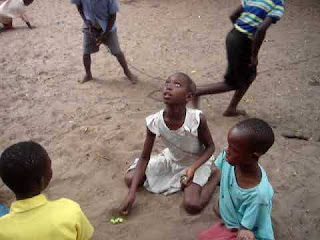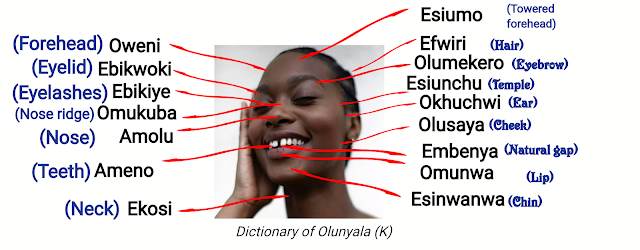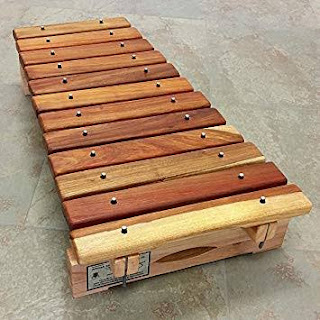ABANYALA BA KAKAMEGA: Animal Housings, Human Houses Structural Parts
Abanyala ba Mukhamba who live in Navakholo Sub-County speak Olunyala (K). The language has names for special dwelling places for various animals. The following are the names for the dwelling places.
GENERAL ANIMAL DWELLING PLACES
- Echibi- a man's house in the home.
- Ekacha- chicken's nest.
- Ekhambalia- house for tortoise.
- Ekhombe- house for birds as holes on tree trunk.
- Ekubiri- widow's house.
- Ekhongoiko- snail shell.
- Ekwaali- a house for a widower before remarriage.
- Eloho- house for black ants
- Enchu- house for human beings especially the married one.
- Erumbi- house used by initiates after circumcision.
- Esibikhwa- housing for white ants called embikhwa
- Esichenyakhwi- house for buginsect
- Esifundukusi- house for dung beetle and mole
- Esifwo- sleeping place for nightjar.
- Esikaali- temporary house structure.
- Esikeke- nest for smallest white ants called owulingiri.
- Esikhuwe- housing for white ants called amakhuwe
- Esikuukha- house of black ants on tree stems and leaves
- Esimba- young boys' house.
- Esimbi- sea shells.
- Esing'uliro- house area for amasimba
- Esiri- nest for ants
- Esisaa-kanya- house for pupae of caterpillars.
- Esisakatia- make shift house; tent.
- Esisasala- house for wasps
- Esisechere- big anthill that houses a type of white ants called amasechere
- Esiswa- nest for white ants
- Esiswi- birds nest made of sticks or grass
- Esita- house for swallow birds
- Esitalatala- goats resting area made of stick walls and flat roof.
- Esitawa- housing for whiteants called endawa.
- Esitioli- dwelling places of domestic animals such as sheep and goat.
- Esituluku- smallest anthill that houses very small ant species.
- Esiyonjo- small basket fir quails housing.
- Olubangachi- caves between stones mainly for bats, deers, lions etc
- Olukulu- dweling area for hyenas in rocks on hills
- Olu-ngo (mubikhongo) dwelling place for cattle. Usually made up of pegs and fence on the outside.
- Oluwubi- spider's house
- Olunjiho- house of small bee species on walls
- Olusongo- small insect house made of potlike soil
- Omulaki- many big baskets for quails.
- Omulinga- housing for bees
- Omuliungu- house for carpenter bees
- Owina- house for rats, endukusi and moles
HUMAN DWELLING PLACES
The construction of houses for human beings and other farm structures were done by experts. Such constructions have specific names for different parts.
a) Names of Rooms in a human's house
- Enachibi- man's room.
- Enalusicho- open room within a house.
- Enalukhubo- corridor in a house especially for leaders.
- Enalusiimbo- enclosed covered area around the eaves of the house.
- Enalwiki- space behind the door.
- Enamayika- cooking area in a one room house.
- Enasitandaliro- space within the house near the cooking place where utensils and cooking paraphernalia were kept.
- Enasisundulo- rooms that form extentions from main body.
- Enasusi- bedroom.
- Enaweru- sitting room and dining area.
- Enasifumbiro- kitchen room.
- Enasikoro- lockable room in house.
- Enasiseenge- part of house meant for chicken or visitors.
- Amateekeyi- small round window openings on the wall of the house.
- Amatooche- verandah usually near the main door where we had some pillar posts supporting the roof.
- Amalobero- ventilation space between the roof and the wall. It left space to ensure ants do not access the grass.
- Ebikingi- posts supporting the floor of a granary. They were usually Y shaped onto which horizontal logs rested.
- Echabekalwa- door locking bar from the inside of the house.
- Ekheti- rails on wall or roof. They were fixed in place using ropes.
- Embafu- sides of a granary made of woven sticks.
- Emiakanira- part of emikulo that do not reach the apex if the house.
- Emiiki- door posts that supported the woven door in the middle.
- Ererwe- wall plate beam that secured the wall posts in place and acted as rests for the roofing poles.
- Esichibi- raised platforms arount the inner wall for stabilising pots and holding reeds for light.
- Esifundulo- general extension on the outer wall of the house.
- Esihani- beam or rail or rope extending from one side of the wall to the other in the bedroom for hanging on items of clothing.
- Esikhomekho- door locks from inside
- Esilama- the entire roofing structure of a granary
- Esiro- main roofing beam on a house. Key representative of the man in the home. Upon death, the wife removes it.
- Esisuli- the entire roof structure of a house
- Esita- general body enclosed by walls and covered by esisuli.
- Eta- wall of house.
- Etekula- baked clay slates used for roofing to cover leaking spots.
- Etiko- grass end tip capping fixed at the apex of a house to make it water tight.
- Mumiki- epen door space.
- Olubale- lower floor from the inside of a granary.
- Olukungumirisi- roof ridge.
- Olunika- upper rim of the granary.
- Olusicho- wall separating rooms inside a house.
- Olusisi- lower floor from the outside of a granary which rests on the horizontal bars called olwalo.
- Olusuli- house apex tip beam.
- Olutefwe- upper space between the lower part of roof that extends out and wall.
- Oluwanyamachi- the lower eaves extention of the roof aimed at directing rain water away from the house.
- Olwalo- horizontal bars on which a granary rests. Also used for the granay's space between the bars and the ground.
- Olwiki- woven door
- Omukhingaki- doorstep bar.
- Omukhomekho- it closes the door from inside.
- Omukongo- roof ridge on houses which were not circular.
- Omukuchu- raised soil levels at the base of the wall for support and reducing dampness.
- Omukulo- supportive roofing struss beams that reaches the apex of the root.
- Omwotosi- bar at top of doorframe.
- Ouchabi- hinges
- Oupata- door lock on outside
- Oweru- floor.









Comments
Post a Comment